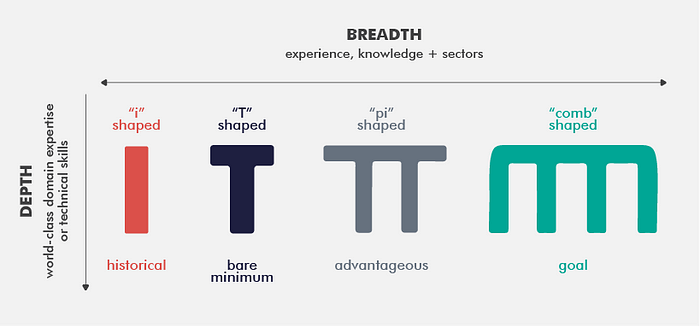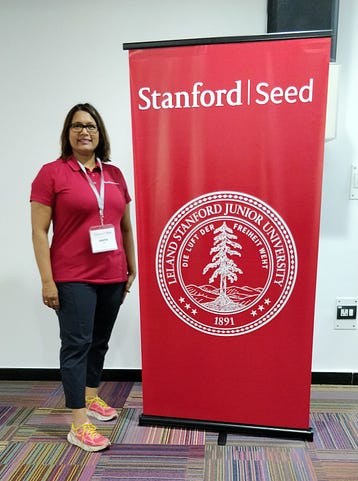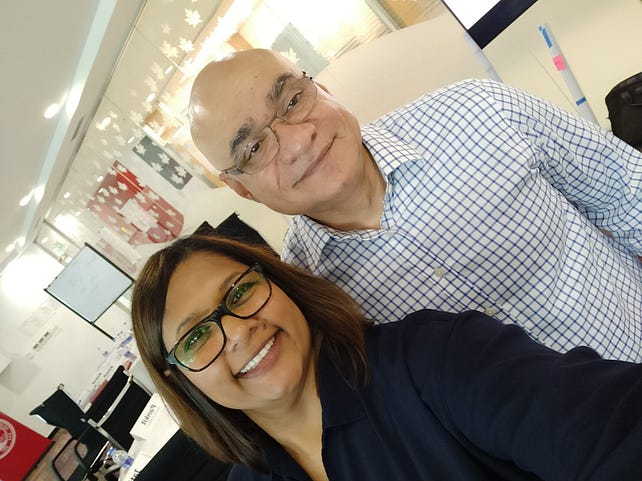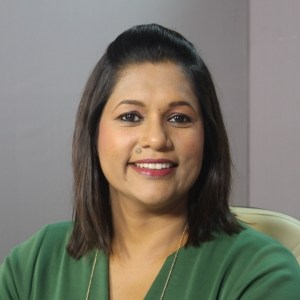Gone are the days of one and done
This ain’t your daddy’s degree. Fill your toolbox and embrace the possibilities.

Earlier this month, when my dermatologist asked me what my 15-year-old daughter “wants to do,” I answered honestly, with a straight face: “astronaut, photographer, supreme court justice, barista, marine biologist, and professional trekker.”
He was bewildered by my answer; after all, how would she select a “stream” for 11th and 12th grades or a college major with such a wide range of interests? I can understand his confusion, because, like many parents in India, he believes that nailing the “right” stream or major literally means end of discussion for education and career decisions. I, on the other hand, don’t really care (to a certain extent) “what” my children study at university, nor does it actually matter anymore. What is more important is that they develop the capacity to keep learning, questioning, innovating and creating throughout their lives.
LIKE NOTHING WE’VE SEEN BEFORE
In the world of modern work, 9-to-5 jobs and careers with a single company are no longer the norm. Instead, the pervasiveness of technology, and the accessibility it facilitates, has changed the very nature of human work. Members of today’s workforce, as well as those of the foreseeable future, control their own destinies — whether it be daily schedule, work location or length and format of employment. With that level of personal control in building a career comes the ever-present need to remain relevant. And, to remain relevant, an individual must embrace change, be willing to learn what is pertinent for a particular industry, place, era or paradigm. That means education, too, takes on a new avatar — the “one and done” framework that prevailed for much of the last century is obsolete. It is being replaced with the notion of lifelong learning, which requires individuals to be flexible, open and cross-disciplinary in their approach.
I laid out my logic to the doctor: Since the jobs of the future will demand a fusion of skills from a range of fields, it is critical that my children know how and when to learn. And then, when faced with a skill gap standing in the way of a goal, they can identify and leverage the right resources to upskill, reskill or just plain old skill. In essence, what I want them to do is become “broad perspective specialists”.
BROAD PERSPECTIVE SPECIALIST
Tim Brown, the CEO of design firm IDEO, popularized the idea of hiring T-shaped talent to deliver innovative solutions. The thinking behind the T-shape is to have deep specialization in one technical area and yet have broad ability in conceptual areas. By using that same logic to build a career, an individual can develop a competitive advantage that is sustainable and flexible. One way to achieve this is to have the initial university degree focus on developing skills that make the impact of technical or subject matter expertise deeper and more meaningful. These skills include critical thinking, interdisciplinary collaboration, giving historical context to current ideas, persuasive writing and fostering a sense of influence. And then, over time, creating multiple areas of specialization enables you to develop from T-shaped, to Pi-shaped to eventually comb-shaped.

My daughter may decide to study psychology at college and yet, she won’t necessarily ever work as a psychologist. By completing a holistic curriculum that also requires math, physics, religion, economics and history, for example, she will be able to use the lens of psychology to better understand why wars were fought (religion and history) or why certain nations are allies and others foes (economics and history) or why people perceive light in ways that don’t always align with the laws of nature (math and physics). She can then deploy that lens to work as a photographer (pun intended!), intellectual property lawyer, social entrepreneur or design engineer — that is, once she completes specialization-intensive courses, micro-degrees or apprenticeships in the associated fields.
EXAMPLE: THE DIFFERENT FILTERS OF CLIMATE CHANGE
Climate change is an issue that affects the world, and future careers, in various ways. If a young person wants to understand what climate change means for her family’s manufacturing business or explore the viability of a for-profit social venture to curb the negative impact of climate change or work as an urban planner to effect long-term change, she would be well-served by studying the topic from various angles, which of course, will morph over time.
- History to understand why the industrial revolution happened and its impact on the natural world.
- Natural sciences and geography to understand the earth’s physical makeup and atmosphere to contextualize the effects of greenhouse gases.
- Psychology to dissect why humanity’s understanding of climate change is incomplete and grasp why people resist change.
- Economics to estimate the funding required to combat climate change and to forecast how climate action will affect the economies of different nations.
- Medicine to assess the impact of climate change on human or animal health and longevity.
- Engineering to develop new manufacturing methods to reduce waste.
- Journalism to influence how the issue is portrayed in the media.
- Politics to effect change at a policy level, locally, nationally or internationally.
- Law to understand compliance and regulatory risks with proposed projects.
- Design to use the creative process to put people at the center of sustainable solutions.
SHIFTING TIDES, LONGER LIFESPANS AND THE REACH OF TECHNOLOGY
In the second half of the twentieth century, you could finish college at 21, work for 35 years in a single company, occupation or function, leveraging the knowledge acquired both in university and on the job, and retire at age 67.
According to Klaus Schwab, Founder and Executive Chairman of the World Economic Forum, the arrival of the fourth industrial revolution in the early 1990’s “…. [has and] will fundamentally alter the way we live, work, and relate to one another. In its scale, scope, and complexity, the transformation will be unlike anything humankind has experienced before.”
By extension, it is clear that the ideal education paradigm, too, has shifted permanently — it is unrealistic to expect an 18-year-old today to lock in on a single stream that will define a lifetime path when the future tomorrow cannot even be imagined today.

Other trends and demographic shifts are simultaneously influencing the structure of life and nature of work. While the list below isn’t exhaustive, it offers some insights into why we have entered an era unlike any before.
-
In India, nuclear families are becoming the norm. And many couples are electing to have only one child. This has led to fissures in the cultural concept of an offspring’s obligation to provide financial security for several generations under one roof.
-
Advancements in healthcare are enabling people to live healthier, for longer. That, in turn, means a need for greater financial resources than earlier generations required.
-
Technology is being developed at breakneck speed and universally deployed, with few constraints related to time or place. This is creating industries, jobs, functions and roles that never existed earlier.
-
Near universal mobile and internet connectivity is allowing individuals to access a wider range of educational and professional opportunities locally and globally.
Given all of the above, it becomes clear that “completing” formal education at age 21 is no longer the only, or even preferred, model to achieve career growth, a productive life and financial security. Certainly, some people will be able to build fulfilling careers on the education they receive from elementary school through university. But, for the vast majority, this model of “one and done” learning, done in a single “block”, will not be enough to sustain a lifetime of financial and personal requirements.
Individuals should be open to the idea of learning in bits and pieces, over time and across different formats. Imagine that instead of securing a single degree from a single university, as is the case today, individuals in the future will design their own educational qualifications or degrees using a combination of online, residential and experiential programs. Smaller, modular chunks of education will become the de-facto standard, and learning will become flexible, customizable and a lifelong endeavor.
In fact, even as an alumnus of a renowned business school, with 25+ years’ global work experience, I have myself gone “back to school,” enrolling in the yearlong, application-intensive Stanford Seed Transformation Program (STP), designed to support high potential entrepreneurs in emerging markets. I’ve particularly benefited from neuroeconomics insights offered by Baba Shiv, The Sanwa Bank, Limited, Professor of Marketing, Stanford University, Graduate School of Business and STP instructor, who underscores the need for an open mind: “At a time of rapid change, a transformation in how, when and where we learn is critical to staying on top of the game. The only solution is a commitment to lifelong learning.”


ADAPTABILITY
Technology in all realms, from retail to finance and healthcare to education, is evolving exponentially. Most people and organizations, however, change only logarithmically because change is jarring, requires effort and even then, outcomes are uncertain. People who learn to adapt, versus those who choose to become overwhelmed by the pace of change in the world, will enjoy greater career success and personal satisfaction. They will also accept that change is inevitable; and that acceptance will liberate them from fear. Let me give you an example: Around 2014, taxi drivers protested the arrival of ride sharing services such as Uber. This challenge to the status quo prompted fear and anxiety, given the perceived threat to their livelihoods. While I can empathize with their reaction, I can also envision another approach — accepting the reality of this threat and then mitigating it in creative and sustainable ways. A fear of technology, not heeding changing customer preferences and shunning innovation paralyzed the taxi professionals until change could not be avoided.
LABOR FORCE REALITIES
New models of employment have enabled companies to extract the most optimal outcomes from several angles — financial, scale, speed and competitive advantage. For individuals, a new range of work formats means that a “9-to-5, suit-required, office-based role” is no longer the only option for career advancement, especially in professional fields. With contract assignments, the gig economy, work-from-anywhere and multi-career lives prevailing for the foreseeable future, the definition of employment and employability has become fluid.
Education, however, hasn’t kept pace with this new economic reality. The fixed set of steps to tick off from school through college does incredibly little to prepare workforce entrants for a world of work in which content and facts are outdated by the time you finish a three- or four-year degree. So, then, you might say, “why go to college anyway? Just learn on the job and take courses along the way.” That is a valid proposition; one with many potential outcomes. For some, college, indeed, is not necessary, amounting to a mis-direction of precious financial resources and time. Yet, for others, college represents a once-in-a-lifetime gift — that is, if, instead of focusing on memorizing facts and regurgitating content, they focus on establishing a foundation upon which to keep learning.
In the second part of this article, I will discuss the reasons why the formal university experience still holds value for many.



